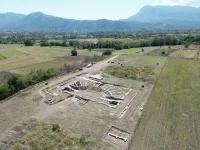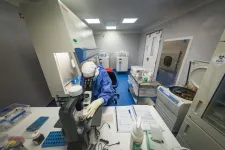(Press-News.org) A spacecraft the size of a cereal box has collected precise measurements of the atmospheres of large and puffy planets called “hot Jupiters.” The findings, led by a team from the University of Colorado Boulder, could help reveal how the atmospheres around these and a host of other worlds are escaping into space.
The observations are the first results to come from a hard-working NASA spacecraft known as the Colorado Ultraviolet Transit Experiment (CUTE).
Kevin France, principal investigator for the mission, will present the group’s results at a media availability Monday, Dec. 11 at 4:30 p.m. at the 2023 meeting of the American Geophysical Union in San Francisco.
The diminutive spacecraft, which measures just 14 inches in length, may be cute, but its scientific findings are anything but. Since its launch in September 2021, CUTE has trained its single ultraviolet telescope at a series of hot Jupiters, some hundreds of light-years from Earth.
Hot Jupiters are among the hottest and angriest planets in the galaxy. As their name suggests, they are gas giants like our own Jupiter. These planets, however, hug much closer to their home stars, completing an orbit roughly once every several Earth days. In the process, stellar radiation cooks hot Jupiters to thousands of degrees Fahrenheit, and their atmospheres swell to enormous sizes, a bit like bread rising in an oven.
Researchers have long suspected that this constant pummeling from stellar radiation could strip away the atmospheres from around some exoplanets over millions-to-billions of years. Data from CUTE suggest that the process might not be so simple.
The CUTE team, which includes several undergraduate and graduate students, has observed seven hot Jupiters so far, with more on the way. Some of them seem to be losing their atmospheres, but others aren’t.
“The planets seem to be coming in all of the flavors,” said France, associate professor in the Laboratory for Atmospheric and Space Physics (LASP) and Department of Astrophysical and Planetary Sciences.
He added that CUTE is helping scientists to build out their field guide to the many kinds of planets that exist in the Milky Way Galaxy—including those that look nothing like Earth’s close neighbors.
“We want to understand how our solar system fits into the family of solar systems in the universe,” France said. “That means understanding the big planets, the small planets, the ones that have life and the ones that definitely don’t—and all of the important physical processes that are operating on these planets.”
Getting hot in here
CUTE’s road to scientific success wasn’t easy.
When the spacecraft first entered into orbit around Earth, France and his colleagues quickly noticed that it seemed to be experiencing a few glitches—a normal problem for many small satellites, or CubeSats, which often test out technology that’s never before flown into space. In one case, the shutter that protected CUTE’s telescope kept snapping shut when it wasn’t supposed to.
The team, which included several undergraduate and graduate students, didn’t give up. The researchers commanded the spacecraft to open its shutter, then drained the battery that fed it, preventing the apparatus from shutting again.
“CUTE is still working and collecting data today,” France said. “When we got our first real science results, it was really exciting.”
CUTE observes distant planets as they pass in front of their home stars, causing ultraviolet light from those stars to dim in the process. In some cases, the spacecraft is so precise that it can detect when starlight dims by just 1%.
In a paper published in September, the researchers described their observations of a world called WASP-189b. This planet orbits a star in the constellation Libra more than 300 light-years, or thousands of trillions of miles, from Earth. It’s also incredibly toasty, with its atmosphere reaching temperatures of roughly 15,000 degrees Fahrenheit, according to the team’s results. That’s thousands of degrees hotter than the surface of the sun.
CUTE’s observations also suggest that gas is escaping from around WASP-189b at a similarly staggering rate of about 400 million kilograms (nearly 900 million pounds) per second.
Planets evolving
Not all of the planets CUTE has studied in its first two years were so exciting. In unpublished results, the team observed a second planet called MASCARA-4b that didn’t seem to be losing much gas at all. Others, like KELT-9b, fell somewhere in the middle.
France and his colleagues hope that their results could help uncover why some planets lose big chunks of their atmosphere, while others remain mostly unchanged. He suspects that it has to do with a combination of the planets themselves (larger planets generate a stronger gravitational pull) and the dynamics of their stars (more active stars likely wreak more havoc on planets than sedate stars).
Those same processes potentially sculpt planets, both in and out of Earth’s solar system, over time. Scientists, for example, theorize that Mars once hosted a much thicker atmosphere, but the sun eroded it away over billions of years.
Atmospheric escape may also explain the origin of a class of planets known as “super Earths,” which are slightly larger than our own world.
“There’s a lot of evidence that suggests that super Earths begin as planets the size of Neptune with large, puffy atmospheres, which then lose so much mass that all that is left is the rocky core and possibly a thin atmosphere,” France said.
CUTE’s greatest legacy may be its impact on students, he said. The mission’s small team of about 20 people were involved in almost every aspect of the spacecraft’s life—from building the satellite to launching it, sending it commands, then downloading and analyzing scientific data. CUTE is currently orbiting about 326 miles (525 kilometers) above Earth’s surface, and is expected to reenter the atmosphere by 2027.
“All of these things are what happens on big NASA missions, just on a much larger scale,” France said. “Our students and early career scientists are getting the full experience from the proposal stage all the way to getting out the science product.”
END
14-inch spacecraft delivers new details about ‘hot Jupiters'
2023-12-12
ELSE PRESS RELEASES FROM THIS DATE:
Patients with a common form of acute myeloid leukemia report better quality of life when treatment includes new drug quizartinib
2023-12-12
DOWNLOADABLE VIDEO
MIAMI, FLORIDA (EMBARGOED UNTIL MONDAY, DEC. 11, 2023 @ 7 P.M. ET) – In a study led by researchers at Sylvester Comprehensive Cancer Center at the University of Miami Miller School of Medicine, patients recently diagnosed with a common and aggressive form of acute myeloid leukemia reported having improved quality of life when a newly approved drug was part of the treatment plan.
Study results will be released during an oral presentation at the 65th ASH Annual Meeting and Exposition, the American Society of Hematology’s conference taking place in San Diego, California, Dec. 9-12. The ...
Roman ‘backwater’ bucked Empire’s decline, archaeologists reveal
2023-12-12
UNDER STRICT EMBARGO UNTIL 00:01 AM (UK TIME) ON TUESDAY 12TH DECEMBER 2023
A rare roofed theatre, markets, warehouses, a river port and other startling discoveries made by a Cambridge-led team of archaeologists challenge major assumptions about the decline of Roman Italy.
New findings from Interamna Lirenas, traditionally written off as a failed backwater in Central Italy, change our understanding of Roman history, its excavators believe.
Their thirteen-year study – published today in the edited volume Roman Urbanism in Italy ...
Genetic “protection” against depression was no match for pandemic stress
2023-12-12
Living through a historic pandemic while handling the stress of the first year of college sent one-third of students in a new study into clinical depression. That’s double the percentage seen in previous years of the same study.
And while certain genetic factors appeared to shield first-year students in pre-pandemic years from depression, even students with these protective factors found themselves developing symptoms in the pandemic years.
In fact, much of the overall rise in student depression during the pandemic was among young women with this kind of “genetic resilience.”
But ...
UC San Diego Health completes acquisition of Alvarado Hospital Medical Center
2023-12-12
On December 11, 2023, UC San Diego Health successfully completed the purchase of Alvarado Hospital Medical Center from Prime Healthcare. The acquisition of the 302-bed medical facility greatly expands the university’s growing network of clinics and hospitals to better serve patients with safe, timely and equitable access to high-quality health care.
“We are grateful to all the teams who contributed to this milestone merger with UC San Diego Health. Together, we start a new chapter to expand access to needed medical and surgical care in eastern ...
Third-generation anti-CD19 CAR T-cells demonstrate efficacy without neurotoxicity in B-cell lymphoma phase 1 clinical trial
2023-12-12
The Malaghan Institute of Medical Research in collaboration with Wellington Zhaotai Therapies Limited today announced results of its phase 1 dose escalation trial of a new third generation anti-CD19 chimeric antigen receptor (CAR) T-cell therapy to be presented at the American Society of Hematology (ASH) Annual Meeting in San Diego on 11 December, 3pm.
Anti-CD19 CAR T-cells with a CD28 co-stimulatory domain, such as axicabtagene ciloleucel and brexucabtagene autoleucel, are among the most effective CAR T-cell therapies for B-cell non-Hodgkin lymphomas but are associated with neurotoxicity (immune effector cell-associated neurotoxicity syndrome, ICANS) in around half of recipients, ...
ASA endorses new legislation to fully avert Medicare payment cuts
2023-12-11
The American Society of Anesthesiologists (ASA) strongly endorses H.R. 6683, legislation that would block a more than 3% Medicare payment cut scheduled to take effect on January 1, 2024. ASA supports the immediate passage of this legislation this year or early 2024, prior to full implementation of these destructive cuts.
“We commend these lawmakers for their leadership on preventing this Medicare payment cut and their efforts to ensure the viability of the nation’s physician practices,” said ASA President Ronald ...
Applications open for School of Advanced Science on Quantum Materials
2023-12-11
Registrations are open to apply for the São Paulo School of Advanced Science on Quantum Materials, to be held on July 6-16, 2024, at the University of São Paulo’s Physics Institute in São Paulo City, Brazil. The School expects to select and fully support 100 graduate students and young researchers (50 from Brazil and 50 from abroad) to take part in short courses and talks focusing on fundamental, theoretical, and experimental aspects of quantum materials – a fertile ...
NASA’s Webb stuns with new high-definition look at exploded star
2023-12-11
Like a shiny, round ornament ready to be placed in the perfect spot on a holiday tree, supernova remnant Cassiopeia A (Cas A) gleams in a new image from NASA’s James Webb Space Telescope. As part of the 2023 Holidays at the White House, First Lady of the United States Dr. Jill Biden debuted the first-ever White House Advent Calendar. To showcase the “Magic, Wonder, and Joy” of the holiday season, Dr. Biden and NASA are celebrating with this new image from Webb.
While all ...
NASA’s MAVEN observes the disappearing solar wind
2023-12-11
In December 2022, NASA’s MAVEN (Mars Atmosphere and Volatile EvolutioN) mission observed the dramatic and unexpected “disappearance” of a stream of charged particles constantly emanating off the Sun, known as the solar wind. This was caused by a special type of solar event that was so powerful, it created a void in its wake as it traveled through the solar system.
Due to this event, MAVEN’s measurements at Mars showed that the number of particles making up the solar wind dropped significantly. Without the pressure of the solar wind, the Martian atmosphere and magnetosphere expanded by thousands of kilometers. MAVEN is the only asset currently at Mars able to ...
Don't say "vegan"
2023-12-11
As presented at the Society for Risk Analysis 2023 Annual conference, Patrycja Sleboda from Baruch College – CUNY and her colleagues from the University of Southern California conducted a national food choice experiment to determine how people respond to labels such as “vegan” and “plant-based” compared to “healthy,” “sustainable,” or “healthy and sustainable.”
Research has shown that limiting meat and dairy intake and eating more fruit and vegetables reduces the risk of cardiovascular diseases, Type 2 diabetes, and cancer. Diets with less meat and dairy are also more environmentally ...




